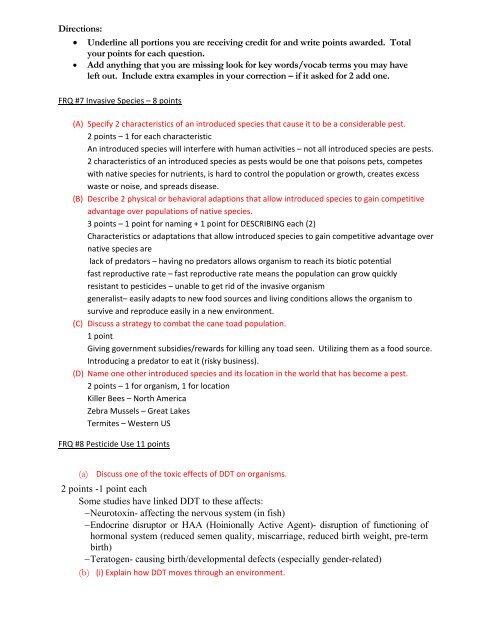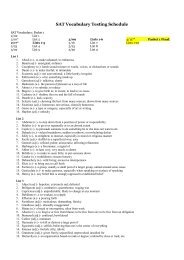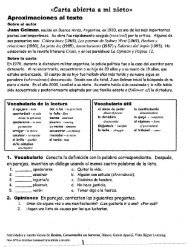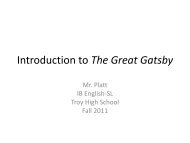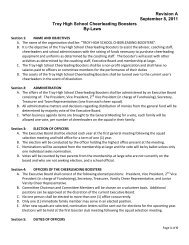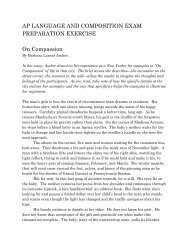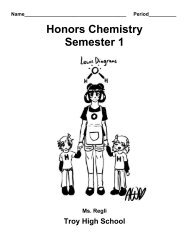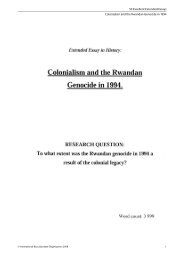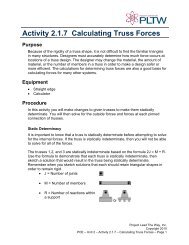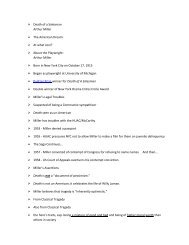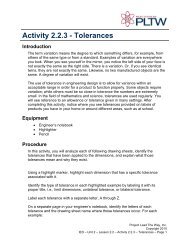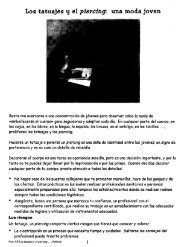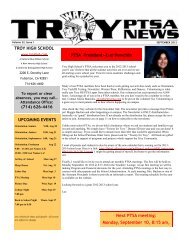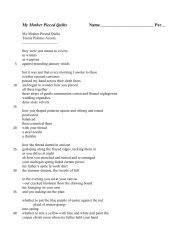FRQ 7 and 8 answers - Troy High School
FRQ 7 and 8 answers - Troy High School
FRQ 7 and 8 answers - Troy High School
Create successful ePaper yourself
Turn your PDF publications into a flip-book with our unique Google optimized e-Paper software.
Directions:<br />
• Underline all portions you are receiving credit for <strong>and</strong> write points awarded. Total<br />
your points for each question.<br />
• Add anything that you are missing look for key words/vocab terms you may have<br />
left out. Include extra examples in your correction – if it asked for 2 add one.<br />
<strong>FRQ</strong> #7 Invasive Species – 8 points<br />
(A) Specify 2 characteristics of an introduced species that cause it to be a considerable pest.<br />
2 points – 1 for each characteristic<br />
An introduced species will interfere with human activities – not all introduced species are pests.<br />
2 characteristics of an introduced species as pests would be one that poisons pets, competes<br />
with native species for nutrients, is hard to control the population or growth, creates excess<br />
waste or noise, <strong>and</strong> spreads disease.<br />
(B) Describe 2 physical or behavioral adaptions that allow introduced species to gain competitive<br />
advantage over populations of native species.<br />
3 points – 1 point for naming + 1 point for DESCRIBING each (2)<br />
Characteristics or adaptations that allow introduced species to gain competitive advantage over<br />
native species are<br />
lack of predators – having no predators allows organism to reach its biotic potential<br />
fast reproductive rate – fast reproductive rate means the population can grow quickly<br />
resistant to pesticides – unable to get rid of the invasive organism<br />
generalist– easily adapts to new food sources <strong>and</strong> living conditions allows the organism to<br />
survive <strong>and</strong> reproduce easily in a new environment.<br />
(C) Discuss a strategy to combat the cane toad population.<br />
1 point<br />
Giving government subsidies/rewards for killing any toad seen. Utilizing them as a food source.<br />
Introducing a predator to eat it (risky business).<br />
(D) Name one other introduced species <strong>and</strong> its location in the world that has become a pest.<br />
2 points – 1 for organism, 1 for location<br />
Killer Bees – North America<br />
Zebra Mussels – Great Lakes<br />
Termites – Western US<br />
<strong>FRQ</strong> #8 Pesticide Use 11 points<br />
(a) Discuss one of the toxic effects of DDT on organisms.<br />
2 points -1 point each<br />
Some studies have linked DDT to these affects:<br />
− Neurotoxin- affecting the nervous system (in fish)<br />
− Endocrine disruptor or HAA (Hoinionally Active Agent)- disruption of functioning of<br />
hormonal system (reduced semen quality, miscarriage, reduced birth weight, pre-term<br />
birth)<br />
− Teratogen- causing birth/developmental defects (especially gender-related)<br />
(b) (i) Explain how DDT moves through an environment.
2 points - 1 point persistence explained + 1 point<br />
Bioaccumulation or Biomagnification explained<br />
Persistence<br />
− DDT is a POP (Persistent Organic Pollution) <strong>and</strong> therefore it does not easily<br />
biodegrade because it is fat soluble <strong>and</strong> stored in the fatty tissues of animals<br />
Bioaccumulation or Biomagnification EXPLAINED<br />
− Because of this it remains in an environment <strong>and</strong> can be bioaccumulated in increasing<br />
concentrations in the fatty tissue of organisms . overtime.<br />
− It is passed from predator to prey up the food chain. Because of the loss of energy at<br />
each trophic level more biomass must be consumed at each level <strong>and</strong> therefore the<br />
concentration of the DDT increases as you move up the food chain.<br />
(ii) Who is most affected, why?<br />
2 points - 1 point name + 1 point discussion why<br />
Possible <strong>answers</strong>- must be named <strong>and</strong> include a discussion of why<br />
• Top level consumers — because of biomagnification up the food chain<br />
• Animals in aquatic environments- because the food chains are often much<br />
more extensive <strong>and</strong> the bioaccumulation is greater<br />
• Infants who are transferred the DDT through the mother's milk <strong>and</strong> are at greater<br />
risk due to size <strong>and</strong> reduced ability to detoxify system<br />
• Mothers – at risk of transferring it to their unborn fetus<br />
• Birds of prey- top level consumers who's endocrine system is affect so that their<br />
eggs do not sufficiently harden <strong>and</strong> offspring are lost<br />
(c) How could DDT be used to alleviate malaria?<br />
1 point<br />
DDT is a potent pesticide, <strong>and</strong> spraying it could kill the anopheles mosquitoes, the<br />
vector of malaria.<br />
(d) Argue your risk assessment of human health between the risks of DDT exposure <strong>and</strong><br />
malaria exposure.<br />
Argue one side – 2 points<br />
MORE RISK WITH DDT<br />
MORE RISK WITHOUT DDT<br />
- So many of the side effects from DDT - More people die a year from malaria<br />
exposure are not well documented <strong>and</strong> exposure than the accumulated possible<br />
can occur over long periods of time.<br />
side effects from DDT<br />
- If there are non-toxic options shouldn't<br />
the precautionary principal be used.<br />
- Should not trade one human health<br />
adverse affect for another- verses<br />
looking for healthy <strong>and</strong> sustainable<br />
alternative.
(e) What are some other methods that could be used to control malaria that do not involve<br />
the use of chemical pesticides? 2 points max – 1 point each<br />
Other means of reducing malaria:<br />
− Bed nets<br />
− Screening for windows <strong>and</strong> doors on houses<br />
− Draining swamp areas<br />
− Increase circulation in tropical lakes (solar pumps, etc)<br />
− Create proper drainage in towns to reduce st<strong>and</strong>ing water<br />
− Education of people to clean up areas of containers which could hold st<strong>and</strong>ing water <strong>and</strong><br />
create breeding areas


